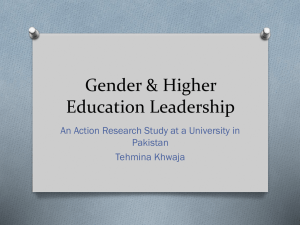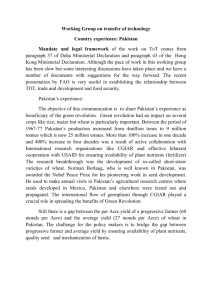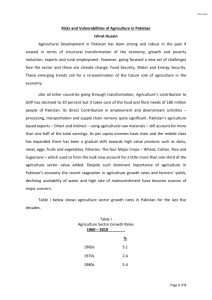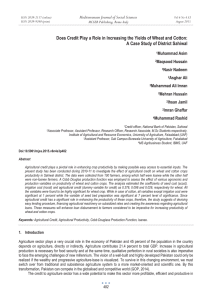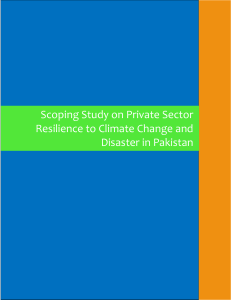Agricultural Productivity and Economic Development
advertisement
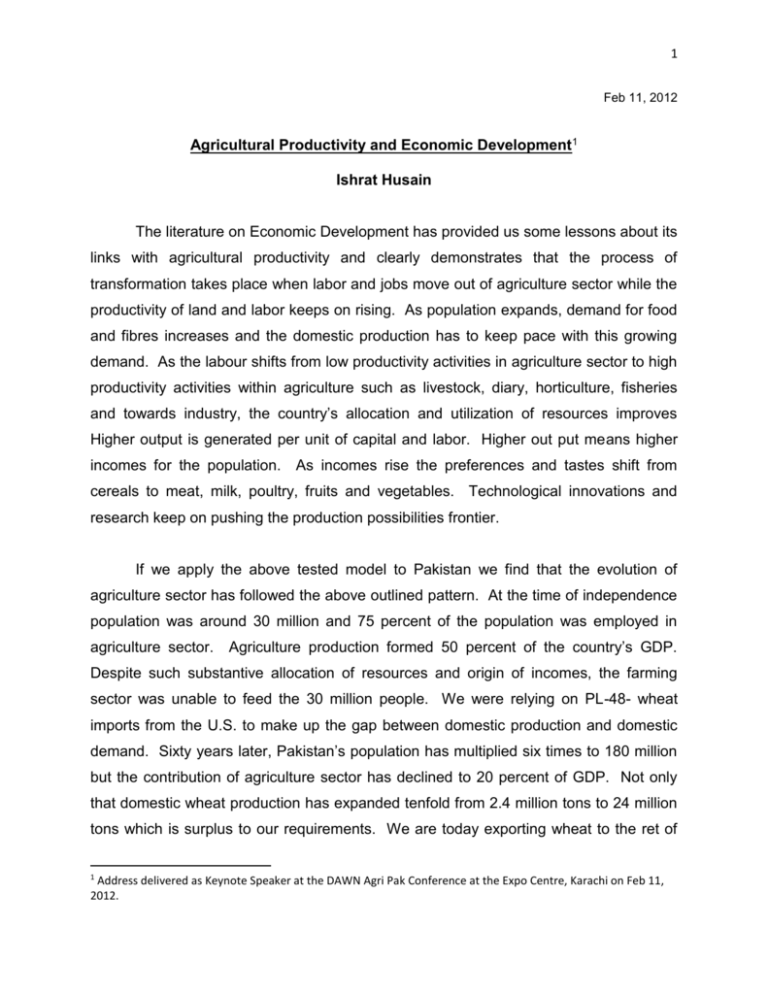
1 Feb 11, 2012 Agricultural Productivity and Economic Development1 Ishrat Husain The literature on Economic Development has provided us some lessons about its links with agricultural productivity and clearly demonstrates that the process of transformation takes place when labor and jobs move out of agriculture sector while the productivity of land and labor keeps on rising. As population expands, demand for food and fibres increases and the domestic production has to keep pace with this growing demand. As the labour shifts from low productivity activities in agriculture sector to high productivity activities within agriculture such as livestock, diary, horticulture, fisheries and towards industry, the country’s allocation and utilization of resources improves Higher output is generated per unit of capital and labor. Higher out put means higher incomes for the population. As incomes rise the preferences and tastes shift from cereals to meat, milk, poultry, fruits and vegetables. Technological innovations and research keep on pushing the production possibilities frontier. If we apply the above tested model to Pakistan we find that the evolution of agriculture sector has followed the above outlined pattern. At the time of independence population was around 30 million and 75 percent of the population was employed in agriculture sector. Agriculture production formed 50 percent of the country’s GDP. Despite such substantive allocation of resources and origin of incomes, the farming sector was unable to feed the 30 million people. We were relying on PL-48- wheat imports from the U.S. to make up the gap between domestic production and domestic demand. Sixty years later, Pakistan’s population has multiplied six times to 180 million but the contribution of agriculture sector has declined to 20 percent of GDP. Not only that domestic wheat production has expanded tenfold from 2.4 million tons to 24 million tons which is surplus to our requirements. We are today exporting wheat to the ret of 1 Address delivered as Keynote Speaker at the DAWN Agri Pak Conference at the Expo Centre, Karachi on Feb 11, 2012. 2 the world. Pakistan has become the third largest exporter of rice in the world after Thailand and Vietnam and its share in international rice trade has risen from 6.9 percent in 1985 to 14 percent in 2005. The country is fifth largest producer of cotton with cotton production of 14 million bales from a modest beginning of 1.7 million bales in early 1950s. We are self sufficient in sugarcane and through fluctuations in output characterize production this year we have exportable surplus. Milk production has taken a big jump and Pakistan is the fourth largest producer in the world of milk. These changes have all taken place as the share of labor has declined to about 40 percent. Land and water resources have not risen proportionately but the increases have taken place mainly due to gains in labor and agricultural productivity. Within agriculture sector, livestock and dairy have emerged as the prime mover of agricultural growth with the crop sector taking a secondary position. This sector now contributes to 55 percent to agriculture value added and about 11.5 percent of GDP and its share is gradually on incline. Within the crop production sector, commercial crops such as oilseeds, horticulture sector, cotton and sugarcane assumed greater significance relative to cereals which were leaders until 1980s. The importance of livestock, diary and poultry to poverty reduction needs to be emphasized. Unlike other countries which have commercial rangelands and large scale organized livestock farms, in Pakistan millions of small farmers and landless labor own a few goats, cows, buffaloes, sheep or poultry. This sub-sector constitutes the main source of food and means of sustenance in rain fed, mountainous and desert ecologies of Pakistan. It is the main agricultural activity in deserts because in these areas crop farming opportunities are relatively few due to very low rainfall, sandy soils and meager availability of good quality ground water. What are the prospects for the future of agriculture in Pakistan? The prospects look quite promising as the yield gaps between progressive farmers and national average are quite wide, varying between 30 percent to 70 percent. If this gap can be reduced for wheat for example, from 40 percent to 30 percent, production increases of 3 about 4-5 million tons can be achieved with the same land and water resources. But there are a number of challenges that the small and medium farmers face in adapting to the practices followed by the progressive farmers. First, the land markets are inefficient and non competitive. Land records are poorly maintained and the discretionary powers enjoyed by the Patwaris and Revenue officials are highly arbitrary. Land titles are missing and the transaction costs of sale, purchase, transfer and mutation are quite high. This opacity can be resolved by computerizing land records and placing them on the web. Second, the middle men or arbiters, who owe their powers to the government’s regulation of produce market, have created a big wedge between the prices received by the small farmers and the retail prices. The rents which are shared between the officials and the middle men are in excess of the economic rate of return on the services they render. Competitive markets open to the private sector would wipe off these rents and strengthen the incentive of the producers. Third, the water market is both inequitable and inefficient. Water courses are tampered by the influential and well connected farmers at the head and the tail enders are denied their share of water. Over flooding of some farms and lack of availability of water at the critical time have led to inefficient use. Sprinkler and other forms of irrigation along with zero tillage, laser leveling and regular de-weeding can curb these inefficient applications. Water course lining can reduce the conveyance losses and a more realistic water pricing policy to recover at least the O&M costs will help in better utilization of this scarce resource. Fourth, the supply chain from farm to fork can be improved if large organized retail and wholesale supermarkets and hypermarkets are encouraged to set up their shops in the major urban areas. Both the quality of the produce from the consumer’s perspective and the price received by the producer will benefit from this supply chain. 4 Fifth, the formation of clusters at the mandi towns, where inputs are available, processing facilities can be accessed, output can be disposed off, advice and technical help can be procured, credit is disbursed by the banks, small implements and machinery sales and service for shops are set up, will make a huge difference to the small and medium farmers’ daily lives. Sixth, the agri-business has to move from small scale, informal and unorganized set of activities relying on antiquated and outdated technology, poor marketing of products to more organized, formal and medium and large scale firms who have both the capital as well as know-how and expertise to add value. Small industries corporations can set up common facilities to service and cater to the needs of the private firms. Seventh, Halal market is now a huge market for meat but Pakistan has not taken advantage of this opportunity. Hygienic abbatoirs meeting the highest standards of health and safety complying with FDA regulations should be set up with linkage to downstream activities such as animal breeding, feeding, health and vaccination, etc. Eight, Pakistan’s large coastal belt offers excellent sea food for domestic consumption and exports. Lack of quality and hygienic standards at the point of origin have pushed European Union (EU) to discontinue exports of seafood from Pakistan. The country is thus deprived of few hundred million dollars of foreign exchange earnings. The quality compliance standards of EU are not only beneficial for them but also for the domestic consumers of sea food. Gwadar Port, Korangi Fish Harbour and Karachi Fish Harbour should be regulated to make this compliance possible opening the resumption of exports to the European market. Ninth, the effluent disposal and the resulting toxic contamination of our harbours is not only environmentally harmful but also poses a risk to the health of the communities living and deriving their livelihoods. Environmental protection and curbing of water pollution should be given priority as a matter of public policy. 5 Finally, a credit to small farmers micro entrepreneurs, agro processing units and agri-business in the rural areas and mandi towns has been a major constraint in adopting new technologies, enhancing productivity, adding value, assuring storage and marketing of the products. Although the State Bank of Pakistan has played a key role in bringing commercial banks in the net of disbursing agriculture credit but the impact has been limited to only 15 percent of the target market. Similarly, microfinance has reached out to 2 million borrowers but a majority is still unable to access micro credit. More vigorous efforts should be made to expand the client base of agriculture credit as well as microfinance.






